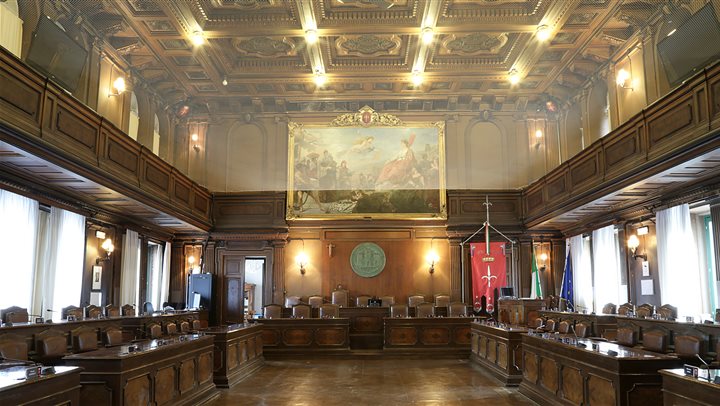Trieste’s City Hall
Designed by architect Giuseppe Bruni, Trieste's City Hall was built between 1873 and 1875 on the site previously occupied by the Magistrate's Palace and the Loggia with a bell tower, for use by the city council with a gallery for the public.
The eclectic style facade gives the building a monumental grandeur, forming a beautiful scenic backdrop of a stage, open to the sea.
The clock tower rises from the central section with two bronze Moors (sculpted by Franco Asteo and replaced by copies in 1972) that locals call "Michez and Jachez striking the hours". The two wings, somewhat simpler, complete the building in a tight game of fornices and chiaroscuro.
Inside, the great Council Hall, is embellished with fine wooden furnishings and the allegorical painting "Prosperous Trade of Trieste" by Caesar Dall'Acqua. Among the many reception rooms, the Blue Room, welcomes authorities and important guests.
At the time of its completion, the Palace was considered unpleasant, a questionable example of architectural contamination, including Venetian reminiscences (The Sansovino Library, and St.Moisè by Tremignon) and Central European mannerisms (The Louvre Pavilion in Paris and The Friedrichsbau in Heidelberg).
A famous sonnet by Giglio Padovan echoes the popular jokes, in which the new City Hall was a "cheba" (birdcage), a "budel de leonfante", (elephant gut), a "castel de mandolato" (marzipan castle), a "punishment from God ".
Only a century later, the work had been called "one of the most notable building in the genre that were produced in Europe and in the world at that time" (Firmiani/1975).
In fact, Bruni not only proved to be an excellent facade designer (in 1871 he had built the nearby Palazzo Modello), but also and above all, a brilliant urban planner, having understood first the orientation and the harmonious integration of the buildings that would later have breathed life into the monumental square overlooking the sea, the largest in Europe.
On September 18, 1938 from a stage in front of the Palace Mussolini announced the promulgation of the Fascist racial laws in Italy. On November 4, 1954 from the central balcony of the Palace itself the President of the Republic, Luigi Einaudi, together with Mayor Gianni Bartoli, greeted a square crowded with people celebrating the return of Italy to Triest.






